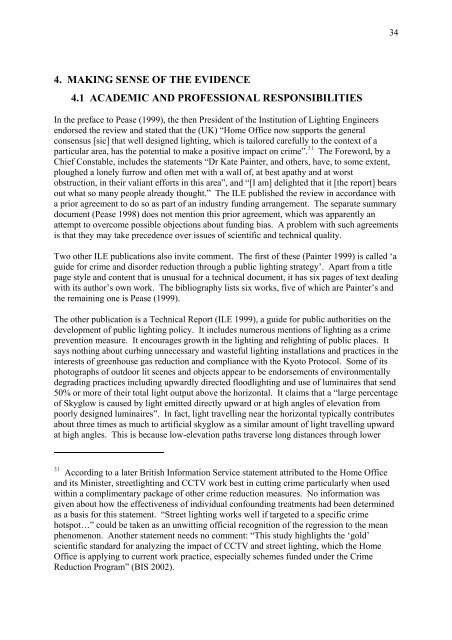Outdoor Lighting and Crime - Amper
Outdoor Lighting and Crime - Amper
Outdoor Lighting and Crime - Amper
You also want an ePaper? Increase the reach of your titles
YUMPU automatically turns print PDFs into web optimized ePapers that Google loves.
4. MAKING SENSE OF THE EVIDENCE<br />
4.1 ACADEMIC AND PROFESSIONAL RESPONSIBILITIES<br />
In the preface to Pease (1999), the then President of the Institution of <strong>Lighting</strong> Engineers<br />
endorsed the review <strong>and</strong> stated that the (UK) “Home Office now supports the general<br />
consensus [sic] that well designed lighting, which is tailored carefully to the context of a<br />
particular area, has the potential to make a positive impact on crime”. 31 The Foreword, by a<br />
Chief Constable, includes the statements “Dr Kate Painter, <strong>and</strong> others, have, to some extent,<br />
ploughed a lonely furrow <strong>and</strong> often met with a wall of, at best apathy <strong>and</strong> at worst<br />
obstruction, in their valiant efforts in this area”, <strong>and</strong> “[I am] delighted that it [the report] bears<br />
out what so many people already thought.” The ILE published the review in accordance with<br />
a prior agreement to do so as part of an industry funding arrangement. The separate summary<br />
document (Pease 1998) does not mention this prior agreement, which was apparently an<br />
attempt to overcome possible objections about funding bias. A problem with such agreements<br />
is that they may take precedence over issues of scientific <strong>and</strong> technical quality.<br />
Two other ILE publications also invite comment. The first of these (Painter 1999) is called ‘a<br />
guide for crime <strong>and</strong> disorder reduction through a public lighting strategy’. Apart from a title<br />
page style <strong>and</strong> content that is unusual for a technical document, it has six pages of text dealing<br />
with its author’s own work. The bibliography lists six works, five of which are Painter’s <strong>and</strong><br />
the remaining one is Pease (1999).<br />
The other publication is a Technical Report (ILE 1999), a guide for public authorities on the<br />
development of public lighting policy. It includes numerous mentions of lighting as a crime<br />
prevention measure. It encourages growth in the lighting <strong>and</strong> relighting of public places. It<br />
says nothing about curbing unnecessary <strong>and</strong> wasteful lighting installations <strong>and</strong> practices in the<br />
interests of greenhouse gas reduction <strong>and</strong> compliance with the Kyoto Protocol. Some of its<br />
photographs of outdoor lit scenes <strong>and</strong> objects appear to be endorsements of environmentally<br />
degrading practices including upwardly directed floodlighting <strong>and</strong> use of luminaires that send<br />
50% or more of their total light output above the horizontal. It claims that a “large percentage<br />
of Skyglow is caused by light emitted directly upward or at high angles of elevation from<br />
poorly designed luminaires”. In fact, light travelling near the horizontal typically contributes<br />
about three times as much to artificial skyglow as a similar amount of light travelling upward<br />
at high angles. This is because low-elevation paths traverse long distances through lower<br />
31 According to a later British Information Service statement attributed to the Home Office<br />
<strong>and</strong> its Minister, streetlighting <strong>and</strong> CCTV work best in cutting crime particularly when used<br />
within a complimentary package of other crime reduction measures. No information was<br />
given about how the effectiveness of individual confounding treatments had been determined<br />
as a basis for this statement. “Street lighting works well if targeted to a specific crime<br />
hotspot…” could be taken as an unwitting official recognition of the regression to the mean<br />
phenomenon. Another statement needs no comment: “This study highlights the ‘gold’<br />
scientific st<strong>and</strong>ard for analyzing the impact of CCTV <strong>and</strong> street lighting, which the Home<br />
Office is applying to current work practice, especially schemes funded under the <strong>Crime</strong><br />
Reduction Program” (BIS 2002).<br />
34
















